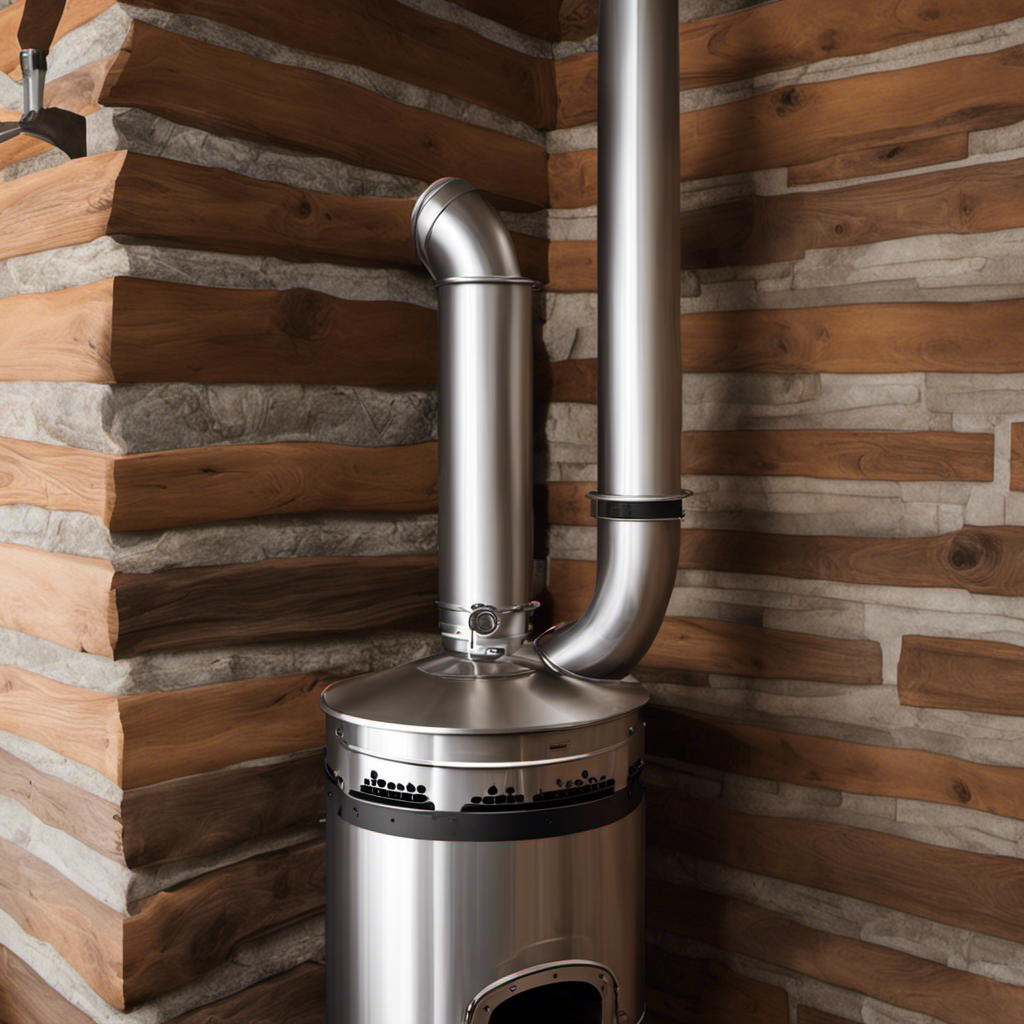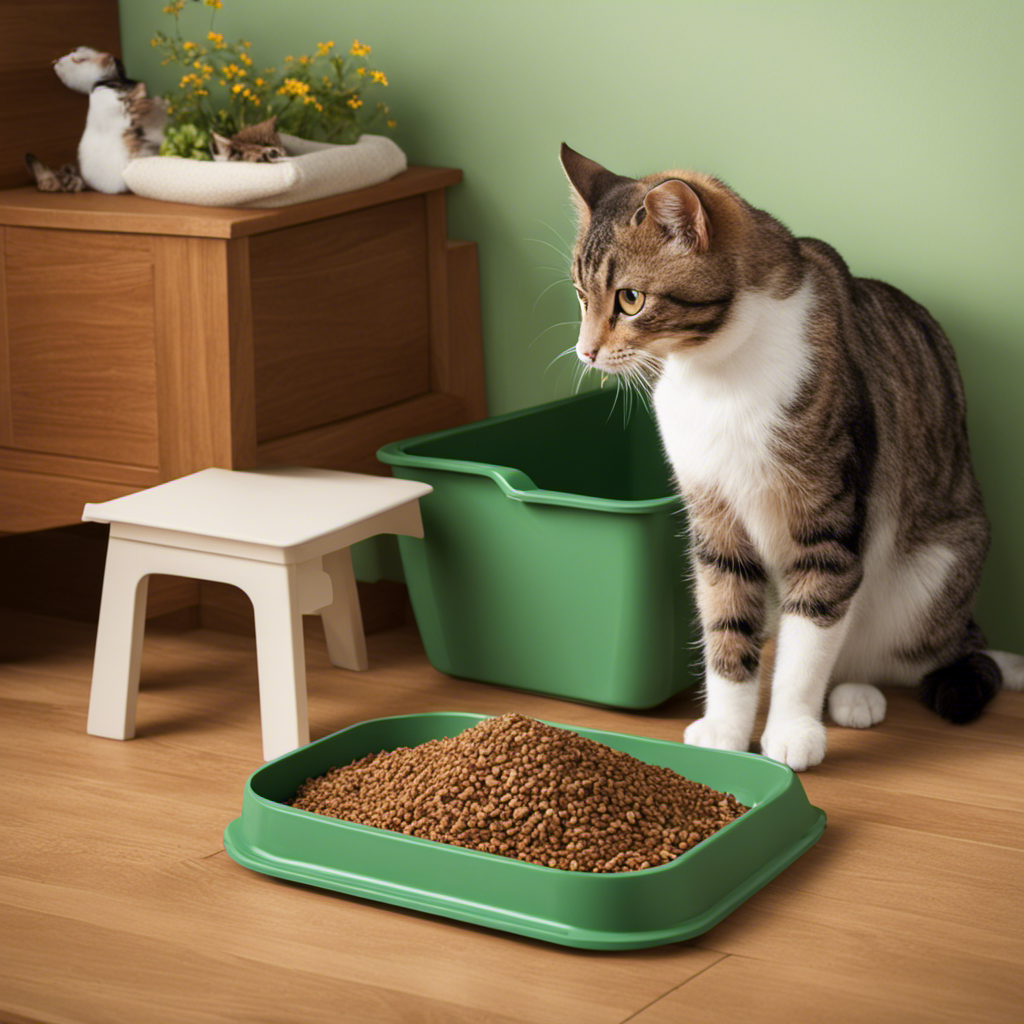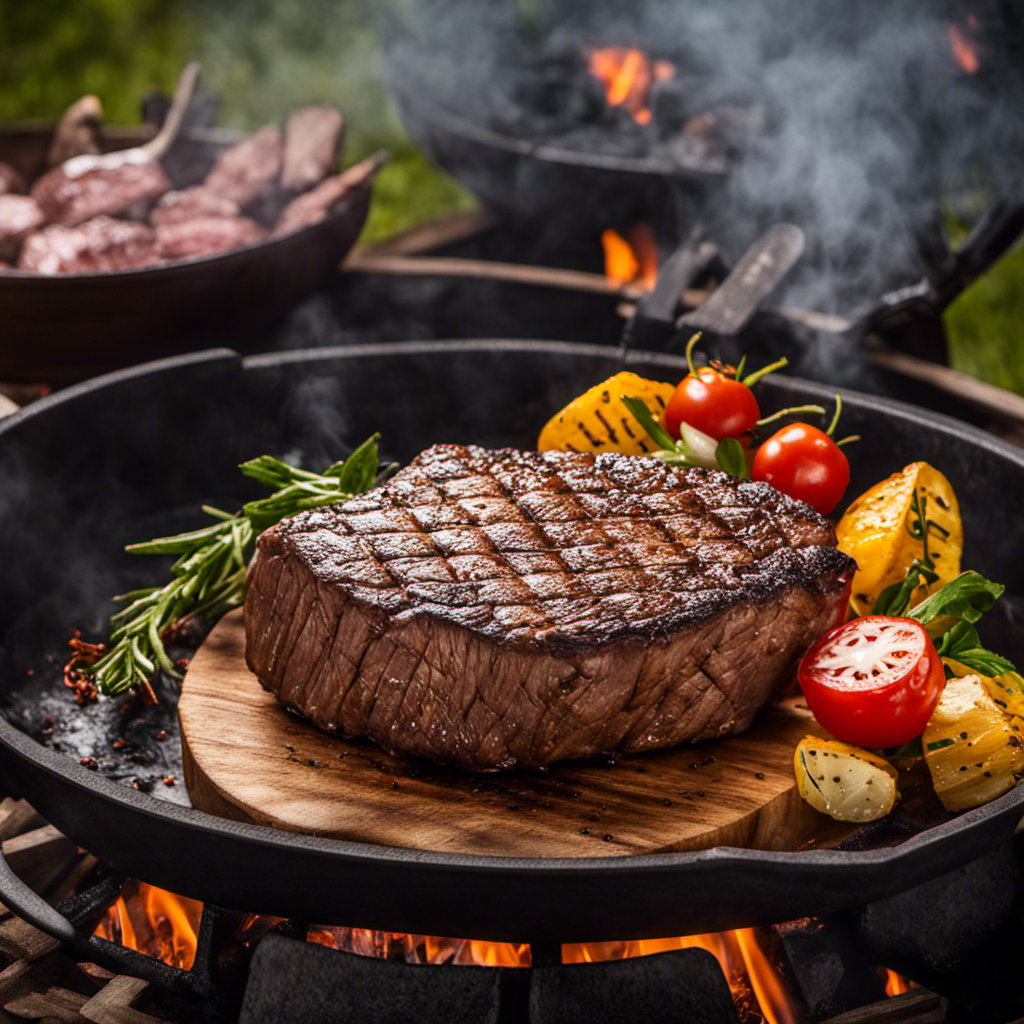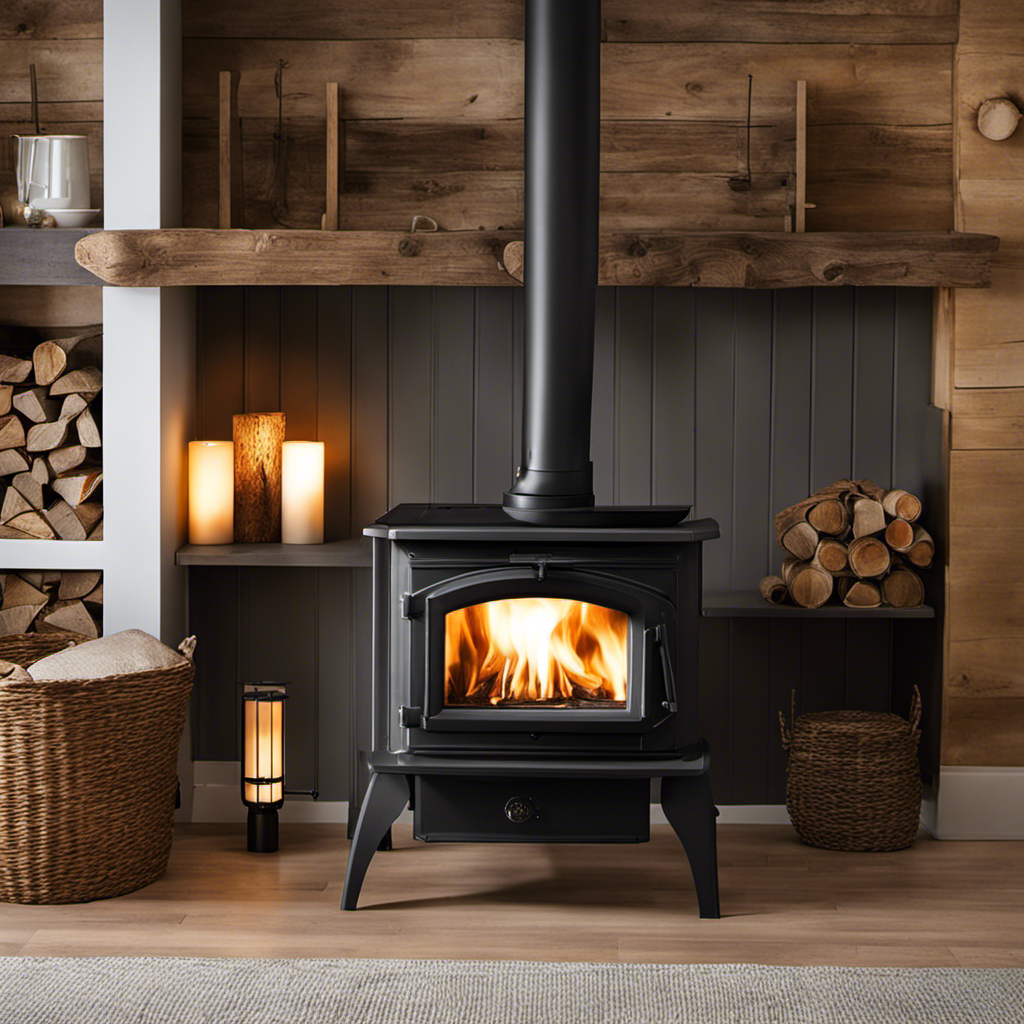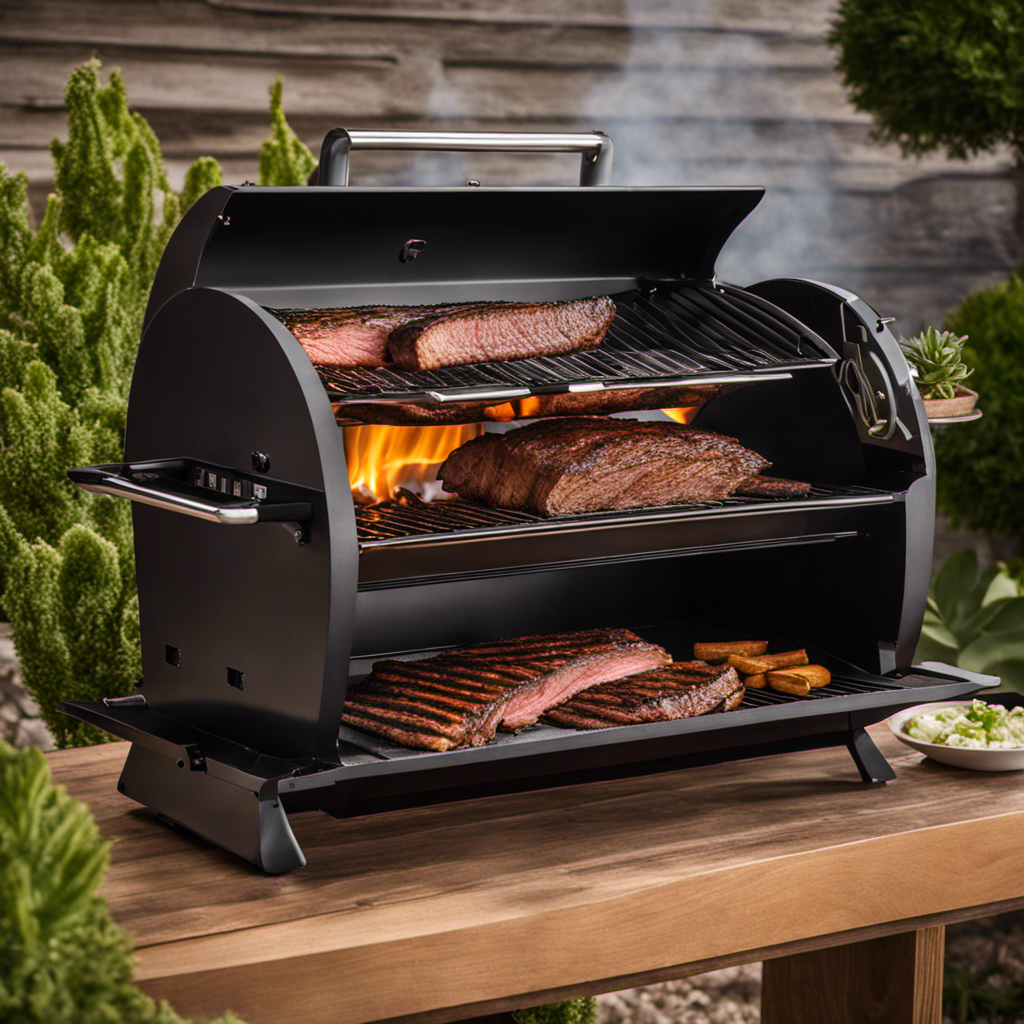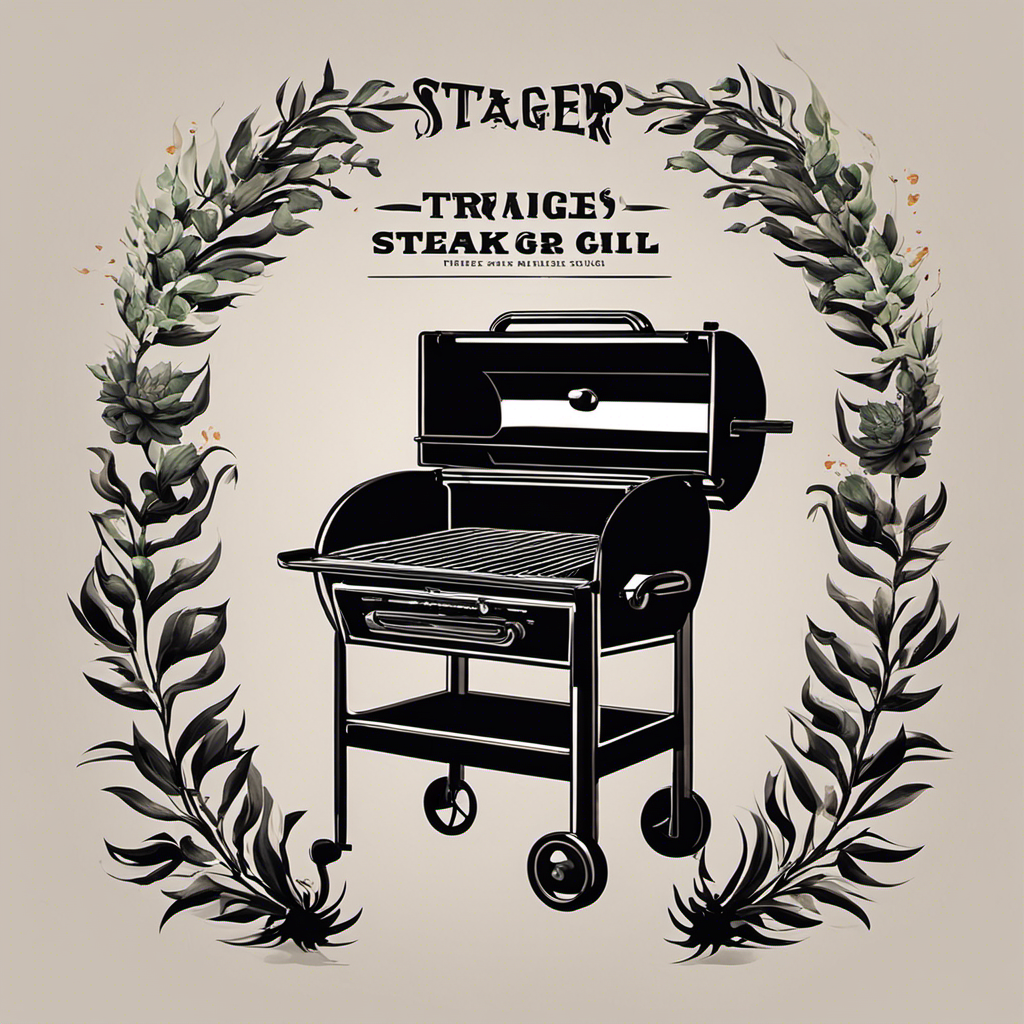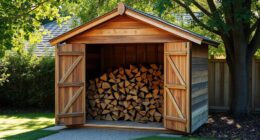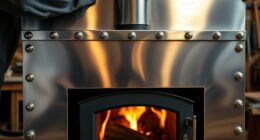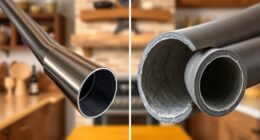I’ve found that using an 8 inch wood stove pipe as a conduit for a pellet stove pipe can be an extremely efficient and economical option.
In fact, did you know that by properly venting your pellet stove with a wood stove pipe, you can ensure optimal performance and minimize heat loss?
In this article, I will guide you through the process of choosing the right adapter, understanding the differences between wood and pellet stove pipes, and provide step-by-step instructions for installation.
Let’s dive in!
Key Takeaways
- Choose the right adapter and ensure a secure connection between the wood stove pipe and the pellet stove pipe.
- Understand the differences between wood stove pipes and pellet stove pipes in terms of material compatibility and construction.
- Consider the ventilation requirements for both types of stoves and ensure proper installation.
- Perform regular maintenance and inspections to prevent blockages and ensure safe and efficient operation.
Choosing the Right Adapter for Your Wood Stove Pipe
When choosing the right adapter for your wood stove pipe, it’s important to consider the size and type of pellet stove pipe you will be using. Wood stove pipe adapters are crucial in ensuring a proper connection between the different types of pipes. Compatibility issues can arise if the adapter is not chosen correctly, leading to leaks or inefficient performance.
To avoid these problems, measure the diameter of both your wood stove pipe and pellet stove pipe accurately. This will help you select an adapter that fits snugly and securely. Additionally, pay attention to the material of both pipes as certain adapters are designed specifically for different materials like stainless steel or galvanized steel.
Understanding these factors will ensure a successful transition from your wood stove pipe to a pellet stove pipe without any issues.
Now let’s delve into understanding the differences between wood stove pipes and pellet stove pipes…
Understanding the Differences Between Wood Stove Pipes and Pellet Stove Pipes
When it comes to material compatibility, there are distinct differences between wood and pellet stoves. Wood stoves are designed to burn solid wood logs, while pellet stoves require compressed wood pellets as fuel. This means that the components used in their construction, such as the stove pipe, must be specifically designed for the type of fuel being burned.
Another important consideration is ventilation requirements. Wood stoves typically require a chimney or flue system that provides proper airflow for combustion and exhaust. Pellet stoves, on the other hand, often utilize a forced air system with an exhaust fan to ensure efficient operation. This means that the ventilation needs of each type of stove differ significantly.
Proper installation is crucial for both wood and pellet stoves to ensure safe and efficient operation. The setup process involves factors such as clearances from combustible materials, proper sealing of joints and connections, and adherence to local building codes and regulations. It is important to consult the manufacturer’s instructions or seek professional assistance during installation to ensure everything is done correctly.
Material Compatibility: Wood Vs Pellet
The material compatibility of wood stove pipe and pellet stove pipe can vary. It is important to consider the specific requirements of each type of stove when it comes to material compatibility. Wood stove pipes are typically made from stainless steel or galvanized steel. These materials can withstand high temperatures and the corrosive byproducts of burning wood. On the other hand, pellet stove pipes are usually made from aluminum or stainless steel. This is due to their lower operating temperatures and cleaner combustion process.
In terms of installation techniques, both types of pipes require proper sealing and secure connections. This is to ensure efficient operation and prevent leaks. However, there may be slight differences in the specific components used for each type of pipe. It is crucial to consult the manufacturer’s guidelines and local building codes when installing either a wood or pellet stove pipe.
Transitioning into the subsequent section about ventilation requirements, it is essential to understand that both wood stoves and pellet stoves require proper ventilation for safe operation. However, they have different ventilation needs based on their unique combustion processes.
Ventilation Requirements: Different Needs
Both wood stoves and pellet stoves have distinct ventilation requirements due to their unique combustion processes. When it comes to ventilation options, there are some differences between the two.
Wood stoves typically rely on natural draft ventilation, which means that they require a chimney or flue system to ensure proper air flow.
Pellet stoves, on the other hand, can be vented through a wall using either a direct vent or power vent system. Direct venting uses a pipe within a pipe design, where one pipe brings in fresh air for combustion while another carries out the exhaust gases. Power venting utilizes fans to help with air movement and can be beneficial when installing in areas where natural draft is not feasible.
Transitioning into the next section about installation considerations: proper setup, it’s important to understand these different ventilation options before proceeding with the installation process.
Installation Considerations: Proper Setup
To ensure a proper setup during installation, it’s essential to understand the different ventilation options for wood stoves and pellet stoves. Proper insulation and chimney height are key considerations when setting up your stove.
Here are three important points to keep in mind:
-
Insulation: Installing proper insulation around your stove pipe is crucial for maintaining optimal heat transfer and preventing heat loss. This helps maximize the efficiency of your stove and reduces energy waste.
-
Chimney Height: The height of your chimney plays a significant role in creating adequate draft for efficient combustion. A taller chimney creates stronger draft, which improves the airflow and ensures proper venting of smoke and gases.
-
Clearances: It’s crucial to maintain appropriate clearances between the stove, stovepipe, and any combustible materials to prevent fire hazards.
By understanding these ventilation options, you can properly set up your wood or pellet stove for safe and efficient operation.
Now let’s move on to how you can properly vent your pellet stove with an 8 inch wood stove pipe.
Properly Venting Your Pellet Stove With an 8 Inch Wood Stove Pipe
When it comes to venting pellet stoves, ensuring wood stove pipe compatibility is crucial. In this discussion, I will explore how to properly vent your pellet stove using an 8-inch wood stove pipe.
We will also delve into the importance of following proper installation techniques for a safe and efficient operation.
Wood Stove Pipe Compatibility
Using an 8 inch wood stove pipe with a pellet stove pipe is compatible and can be done successfully. When it comes to wood stove pipe installation for a pellet stove, there are some important factors to consider. Here are three key points to understand about the compatibility of these two types of pipes:
-
Size: Ensure that the diameter of your wood stove pipe matches the size of your pellet stove pipe. Both should have an 8-inch diameter for proper connection.
-
Material: Check if your wood stove pipe is made from the appropriate material for venting pellet stoves. It should be constructed from stainless steel or another approved material that can withstand high temperatures and resist corrosion.
-
Clearances: Make sure to follow manufacturer guidelines regarding clearances between the wood stove pipe and any combustible materials. Proper clearances are crucial for safety.
Now that we’ve discussed the compatibility of using an 8 inch wood stove pipe with a pellet stove, let’s move on to understanding how to properly vent pellet stoves without compromising performance or safety.
Venting Pellet Stoves
Now that we’ve covered the compatibility of an 8 inch wood stove pipe with a pellet stove, let’s explore how to properly vent pellet stoves for optimal performance and safety. Ventilation requirements and installation considerations are crucial to ensure efficient operation and prevent potential hazards.
To help you better understand the ventilation requirements, I have prepared a table outlining important factors to consider when venting your pellet stove:
| Ventilation Requirements | Installation Considerations |
|---|---|
| Proper Chimney Height | Correct Pipe Size |
| Adequate Clearances | Horizontal vs Vertical Venting |
| Combustion Air Supply | Exterior vs Interior Installation |
Proper chimney height is essential to create a sufficient draft and allow for proper exhaust expulsion. Choosing the correct pipe size ensures optimal airflow, preventing backdrafts and reducing creosote buildup. Additionally, clearances around the pipe must be adhered to, ensuring safe distances from combustible materials.
Considering whether to install your pellet stove horizontally or vertically is also important. Each option has its own advantages depending on your specific circumstances.
Proper Installation Techniques
To ensure proper installation of your pellet stove, it’s important to follow these recommended techniques for optimal performance and safety.
-
Start by choosing a suitable location that meets all necessary clearances and ventilation requirements. Ensure that the floor beneath the stove is non-combustible and can support the weight of the unit.
-
Follow manufacturer guidelines for connecting the stove to the chimney or venting system, making sure to use high-quality materials and secure connections.
-
Regularly inspect and clean the pellet stove pipe to prevent build-up of creosote and maintain efficient operation.
-
Perform routine maintenance practices such as cleaning the firebox, checking gaskets, lubricating moving parts, and replacing worn-out components as needed.
By following these installation techniques and maintenance practices, you can ensure a safe and reliable operation of your pellet stove.
Transition: Now let’s move on to a step-by-step guide on how to install a pellet stove pipe on your wood stove…
Step-by-Step Guide to Installing a Pellet Stove Pipe on Your Wood Stove
First, let’s go over the step-by-step guide for installing a pellet stove pipe on your wood stove.
When choosing the right adapter, it’s important to consider the size and type of your wood stove pipe. Look for an adapter that matches the diameter of your wood stove pipe and is compatible with both pellet stove and wood stove pipes.
Before installation, make sure your wood stove is properly installed and complies with local building codes.
Begin by cleaning the end of your wood stove pipe to remove any debris or soot build-up.
Next, attach the adapter to the end of your wood stove pipe using appropriate screws or clamps.
Now you’re ready to connect the pellet stove pipe to your wood stove pipe, which we will discuss in more detail in the next section about tips for connecting the two pipes seamlessly.
Transitioning into connecting the pellet stove pipe to your wood stove pipe can be done smoothly by following these additional steps…
Tips for Connecting the Pellet Stove Pipe to Your Wood Stove Pipe
When connecting the pellet stove pipe to your wood stove pipe, make sure you align the seams properly to ensure a tight seal. This is crucial for efficient operation and to prevent any potential leaks. In order to emphasize the importance of proper alignment, consider the following table:
| Seam Alignment | Result |
|---|---|
| Properly aligned | Tight seal, no leaks |
| Misaligned | Potential for leaks and reduced efficiency |
By aligning the seams correctly, you can ensure that no exhaust gases or smoke escape into your living space. Additionally, it is important to regularly maintain your wood stove pipe to avoid any blockages or buildup that may affect its performance. Regular cleaning and inspection will help prevent issues such as creosote buildup or chimney fires.
To ensure a secure and leak-free connection for your pellet stove pipe, there are a few additional steps you should take.
Ensuring a Secure and Leak-Free Connection for Your Pellet Stove Pipe
Proper alignment of the seams is essential to ensure a secure and leak-free connection for your pellet stove pipe during the wood stove pipe installation. When connecting the pellet stove pipe, make sure that the male end of one section fits snugly into the female end of another section. This will create a tight seal and prevent any potential leaks.
It is important to use high-quality materials and follow manufacturer guidelines to ensure a proper connection. Additionally, using stainless steel screws or clamps can provide extra security and stability. By following these steps, you can confidently connect your pellet stove pipe to your wood stove pipe, ensuring efficient operation and minimizing any risks associated with improper installation.
To maintain and clean your wood stove pipe in order to accommodate a pellet stove, regular inspection is crucial. Look for any signs of damage or corrosion that may affect the integrity of the connection between the two pipes. Cleaning should also be done regularly to remove creosote buildup, which can reduce airflow efficiency and increase the risk of chimney fires.
A chimney brush specifically designed for pellet stoves can be used to clean both the interior walls of the wood stove pipe as well as any venting components. Regular maintenance will help keep your wood stove pipe functioning optimally while accommodating a pellet stove.
Maintaining and Cleaning Your Wood Stove Pipe to Accommodate a Pellet Stove
Now that we have ensured a secure and leak-free connection for our pellet stove pipe, it is important to properly maintain and clean our wood stove pipe to accommodate the new installation. Regular cleaning maintenance is essential to keep the wood stove pipe functioning efficiently and preventing any potential issues.
Firstly, it is crucial to remove any creosote buildup from the interior of the wood stove pipe. Creosote can accumulate over time and increase the risk of chimney fires. Using a chimney brush specifically designed for your wood stove pipe size, thoroughly scrub the inside walls of the pipe to remove any creosote deposits.
Additionally, inspecting and replacing damaged insulation around the wood stove pipe is important for heat retention and energy efficiency. Insulation helps prevent heat loss and condensation buildup within the chimney system.
Troubleshooting Common Issues When Running a Pellet Stove Pipe Through a Wood Stove Pipe
If you’re experiencing any issues while running a pellet stove pipe through your wood stove pipe, here are some common troubleshooting solutions:
-
Inspect for blockages: Check if there are any obstructions in the wood stove pipe that may be preventing proper airflow. Clear out any debris or creosote buildup to ensure efficient operation.
-
Ensure proper alignment: Make sure the pellet stove pipe is properly aligned with the wood stove pipe. Misalignment can cause smoke leakage and reduce efficiency. Adjust the pipes as needed to create a tight seal.
-
Check for leaks: Examine the joints between the pipes for any signs of leaks or gaps. Seal any leaks using high-temperature silicone or heat-resistant tape to prevent smoke from escaping.
By following these troubleshooting steps, you can address common issues when running a pellet stove pipe through a wood stove pipe.
Now let’s move on to discussing safety precautions to consider when using an 8 inch wood stove pipe for a pellet stove without compromising your safety and well-being.
Safety Precautions to Consider When Using an 8 Inch Wood Stove Pipe for a Pellet Stove
When using an 8 inch wood stove pipe for a pellet stove, it’s important to consider safety precautions.
One of the key factors to keep in mind is choosing the right adapter. The adapter serves as a connection between the wood stove pipe and the pellet stove pipe. It should be specifically designed for this purpose and ensure a secure and proper fit.
Another crucial aspect is ventilation requirements. Pellet stoves require adequate airflow for combustion and venting of exhaust gases. Make sure your wood stove pipe meets the necessary ventilation standards to avoid any potential hazards such as carbon monoxide buildup or poor performance of the pellet stove.
Regular maintenance and inspections are also essential to ensure optimal safety when using an 8 inch wood stove pipe with a pellet stove.
Frequently Asked Questions
Can I Use a Smaller Wood Stove Pipe for My Pellet Stove?
No, using a smaller wood stove pipe for your pellet stove is not recommended. It may cause improper ventilation and potential safety hazards. There are alternative options available specifically designed for pellet stoves that should be used instead.
How Do I Know if My Wood Stove Pipe Is Compatible With a Pellet Stove Pipe?
To determine wood stove pipe compatibility with a pellet stove pipe, I’d first check the diameter of both pipes. They should match or be easily adapted. Additionally, ensure the materials and construction meet safety standards for pellet stoves.
What Are the Benefits of Using an 8 Inch Wood Stove Pipe for a Pellet Stove?
Using an 8 inch wood stove pipe for a pellet stove offers several benefits. It provides compatibility between the two systems and ensures proper ventilation. Additionally, it allows for efficient heat transfer and reduces the risk of chimney fires.
How Often Should I Clean and Maintain My Wood Stove Pipe When Using It for a Pellet Stove?
I clean and maintain my wood stove pipe for my pellet stove regularly to ensure optimal performance. Cleaning frequency depends on usage, but generally, I recommend inspecting and cleaning it at least once a year. Here are some maintenance tips:
Are There Any Specific Safety Precautions I Should Follow When Using an 8 Inch Wood Stove Pipe for a Pellet Stove?
Using a smaller wood stove pipe for a pellet stove is not recommended due to safety concerns. When using an 8 inch wood stove pipe for a pellet stove, it is important to follow specific safety precautions to prevent any potential hazards.
Conclusion
In conclusion, I was able to successfully run a pellet stove pipe through my 8 inch wood stove pipe by following the proper steps and using the right adapter.
Understanding the differences between the two types of pipes and ensuring a secure connection is key to proper venting and preventing leaks.
It is important to maintain and clean your wood stove pipe regularly to accommodate a pellet stove.
By taking these precautions, you can safely enjoy the benefits of a pellet stove while maximizing efficiency and warmth in your home.

